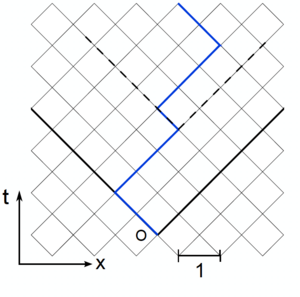L-3: Difference between revisions
No edit summary |
|||
| Line 52: | Line 52: | ||
==Back to the continuum model, a quantuum approach== | ==Back to the continuum model, a quantuum approach== | ||
To fix the idea we can consider polymers of length <math> | To fix the idea we can consider polymers of length <math> | ||
t </math>, starting in <math>x_0 </math> and ending in <math>x_t </math>. | t </math>, starting in <math>x_0 </math> and ending in <math>x_t </math>. | ||
| Line 77: | Line 73: | ||
In this equation the noise is multiplicative and not additive as in the previous lecture. However, all KPZ results can be employed today, thanks to the Cole Hopf transformation. | In this equation the noise is multiplicative and not additive as in the previous lecture. However, all KPZ results can be employed today, thanks to the Cole Hopf transformation. | ||
== Cole Hopf Transformation== | == Cole Hopf Transformation== | ||
Revision as of 19:14, 2 January 2024
Goal: This lecture is dedicated to a classical model in disordered systems: the directed polymer in random media. It has been introduced to model vortices in superconductur or domain wall in magnetic film. We will focus here on the algorithms that identify the ground state or compute the free energy at temperature T, as well as, on the Cole-Hopf transformation that map this model on the KPZ equation.
Polymers, interfaces and manifolds in random media
We consider the following potential energy
The first term represents the elasticity of the manifold and the second term is the quenched disorder, due to the impurities. In general, the medium is D-dimensional, the internal coordinate of the manifold is d-dimensional and the height filed is N-dimensional. Hence,the following equations always holds:
In practice, we will study two cases:
- Directed Polymers (), . Examples are vortices, fronts...
- Elastic interfaces (), . Examples are domain walls...
Today we restrict to polymers. Note that they are directed because their configuration is uni-valuated.
Directed polymers
Dijkstra Algorithm and transfer matrix
We introduce a lattice model for the directed polymer (see figure). In a companion notebook we provide the implementation of the powerful Dijkstra algorithm.
Dijkstra allows to identify the minimal energy among the exponential number of configurations
We are also interested in the ground state configuration . For both quantities we expect scale invariance with two exponents for the energy and for the roughness
Universal exponents: Both are Independent of the lattice, the disorder distribution, the elastic constants, or the boudanry conditions. Note that , while for an interface .
Non-universal constants: are of order 1 and depend on the lattice, the disorder distribution, the elastic constants... However is independent on the boudanry conditions!
Universal distributions: are instead universal, but depends on the boundary condtions. Starting from 2000 a magic connection has been revealed between this model and the smallest eigenvalues of random matrices. In particular I discuss two different boundary conditions:
- Droplet: . In this case, up to rescaling, is distributed as the smallest eigenvalue of a GUE random matrix (Tracy Widom distribution )
- Flat BC: while the other end is free. In this case, up to rescaling, is distributed as the smallest eigenvalue of a GOE random matrix (Tracy Widom distribution )
Back to the continuum model, a quantuum approach
To fix the idea we can consider polymers of length , starting in and ending in . We sum over all possible polymers to compute the partition function at temperature
The previous equation gives the path integral expression of the propagator for a quantum particle, in the imaginary time. Note the the potential is a white noise and thus a time dependent potential.
In the spirit of the Feyman Kac formula we write the time-dependent Hamiltonian of the particle
Hhe partition function is the solution of the Schrodinger-like equation:
The initial condition is .
DISCUTERE CON SATYA LEGAMI FEYMAN KAC FORMULA / transfer matrix
In this equation the noise is multiplicative and not additive as in the previous lecture. However, all KPZ results can be employed today, thanks to the Cole Hopf transformation.









![{\displaystyle E[x(\tau )]=\sum _{\tau =0}^{t}V(\tau ,x)}](https://wikimedia.org/api/rest_v1/media/math/render/svg/93b0356dd1c49f25c798e141e27a40d486be2bfe)

![{\displaystyle E_{\min }=\min _{x(\tau )}E[x(\tau )].}](https://wikimedia.org/api/rest_v1/media/math/render/svg/ad4cafbe3be352ced3ba5e55c5236b8c4444833f)


















![{\displaystyle Z[x_{t},t;x_{0},0]=\int _{x(0)=x_{0}}^{x(t)=x_{t}}{\cal {D}}x\exp \left[-\int _{0}^{t}d\tau (\partial _{\tau }x)^{2}+V(x,\tau )\right]}](https://wikimedia.org/api/rest_v1/media/math/render/svg/7638de32f76cdaa981678082b7e5c98629446f10)


![{\displaystyle Z[x_{t},t=0;x_{0},0]=\delta (x-x_{0})}](https://wikimedia.org/api/rest_v1/media/math/render/svg/3d21e4a58eaa30fce197e432afbb5d82d9dc0e17)